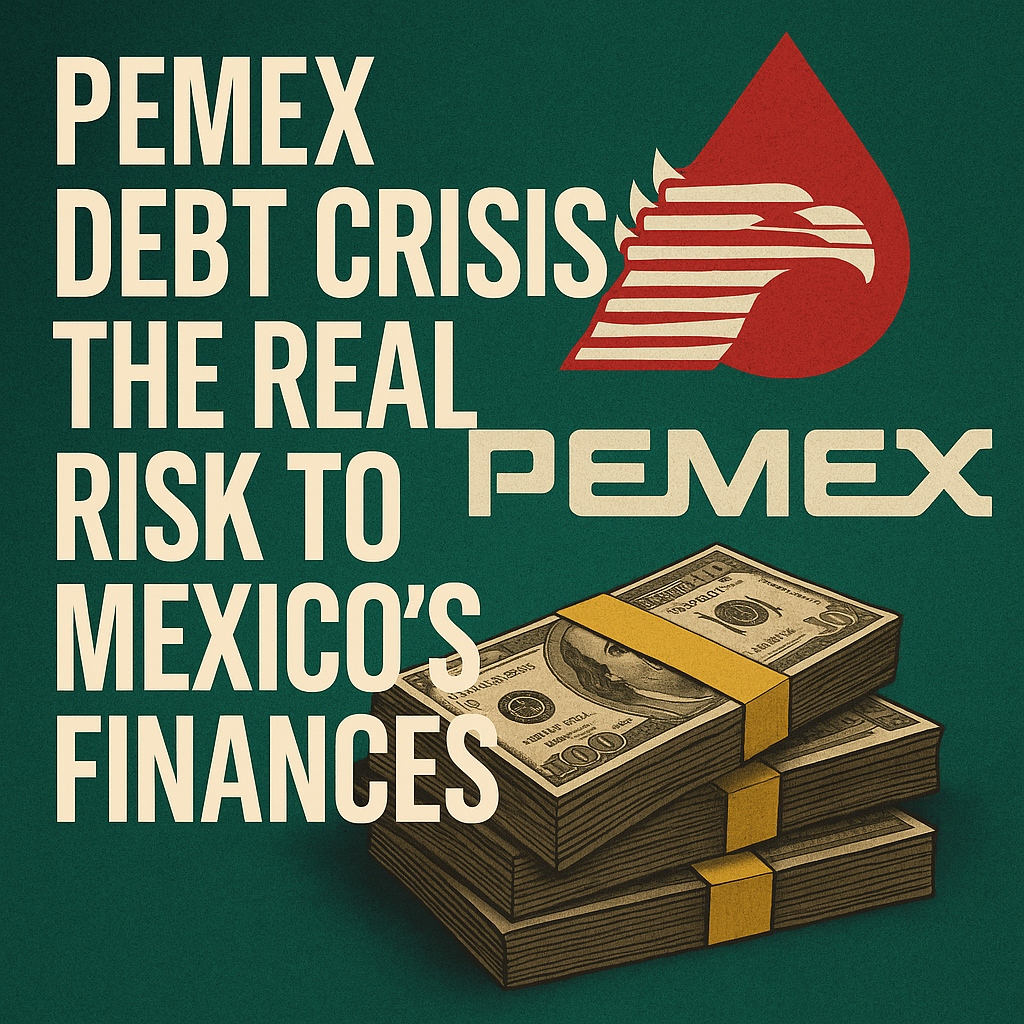Pemex’s Debt Bomb: How Mexico’s Oil Giant Threatens Its Sovereign Balance Sheet
With global concerns mounting over Pemex's staggering debt load — surpassing $100 billion — Rafael Benavente

Mexico’s $100B Oil Dilemma: Pemex Debt and the Risk to National Credit
By Rafael Benavente
🚨 Introduction
In a bold move that reflects both urgency and strategy, the Mexican government has committed to a $7–10 billion debt issuance to support state-owned oil giant Petróleos Mexicanos (Pemex). With global concerns mounting over Pemex's staggering debt load — surpassing $100 billion — this initiative aims to bolster liquidity, reduce borrowing costs, and shield core fiscal stability. Here’s what’s unfolding and why it matters.
💵 What the Government Is Doing
Issuing Pre-Capitalized Notes
Mexico’s Finance Ministry unveiled a plan to issue pre-capitalized notes through a Luxembourg-based SPV (Special Purpose Vehicle). Investors buy these dollar-denominated notes maturing in 2030. The SPV then uses the proceeds to acquire U.S. Treasury bonds — which Pemex subsequently receives to enhance its cash flow without increasing government debt directly Bloomberg.com+8Financial Times+8AInvest+8Reuters+1Financial Times+1.
This sophisticated approach:
- Eases Pemex's need to borrow expensive debt directly.
- Uses high-grade Treasury bonds as collateral.
- Shields federal finances from appearing to back Pemex outright, even though the risks remain indirectly government-backed Financial TimesReuters.
📈 Immediate Market Reaction
Once the plan was announced, Pemex bond yields dropped noticeably:
- The 2050 bond fell from being priced at 10 ¢ to approximately 9.6 ¢ on the dollar Bloomberg Law+12Financial Times+12Bloomberg.com+12.
- Bonds maturing between 2027 and 2031 also showed yield compression.
This bounce signals renewed investor confidence — at least in the short term Reuters.
🧭 Why This Matters Today
- Debt Pressure Relief: Pemex owes over $20 billion to suppliers and faces abrupt due dates in 2025. The arrangement provides a financial stopgap Bloomberg.com+3Financial Times+3X (formerly Twitter)+3.
- Government Risk Management: By structuring the debt via an SPV, Mexico avoids adding liabilities directly to its fiscal books.
- Quick but Imperfect Fix: Experts argue this strategy is effective for liquidity, but structural reforms are still needed to address deep-seated inefficiencies Financial Times.
🏗️ The Bigger Picture: Pemex’s Debt Crisis
- Pemex is the most indebted oil company globally — over $100 billion in liabilities, including $25 billion in unpaid supplier bills Financial Times+1Wikipedia+1.
- Operational performance remains weak; production has hit historic lows, and the state has repeatedly infused cash to keep operations afloat Financial Times.
- The debt sale is part of President Sheinbaum’s broader rescue plan, which includes fiscal reform and efficiency measures Reuters+12El País+12Financial Times+12.
🛠️ What Comes Next?
- Implementation on July 28: Treasury expects to finalize the note issuance.
- Medium-Term Reforms: The government has promised operational restructuring and cost-cutting strategies.
- Investor Watch: Analysts will be watching production trends, supplier payments, and rising bond yields — early signs of whether this patch holds.
💡 Strategic Takeaways
- The debt issuance was market-savvy — leveraging Treasuries to reduce Pemex’s borrowing costs.
- The lack of direct government guarantee still carries a moral hazard risk — and may not resolve underlying production issues.
- Investors view the move as positive but incomplete — confidence is restored in the short run, but long-term viability remains uncertain AInvest+1Reuters+1.
How Pemex’s Debt Skews Mexico’s Sovereign Leverage
Though the Mexican government’s bond rating remains investment grade, Pemex’s financial instability exerts quasi-sovereign pressure. Here’s how:
1. Pemex Debt Treated as Quasi-Sovereign Exposure
- Credit agencies like Fitch and Moody’s factor Pemex’s obligations into Mexico’s overall sovereign risk.
- In 2022 and 2023, Mexico transferred over $10 billion in direct and indirect support to Pemex to service debt and fund operations.
- These transfers increase the government’s contingent liabilities, making Pemex a hidden risk on the nation’s balance sheet.
2. Debt Guarantees and Market Perception
- Although Mexico structured the latest $7–10 billion operation to avoid a direct guarantee, bondholders and rating agencies see through the optics.
- For investors, Pemex bonds are essentially priced as Mexican sovereign risk, meaning any Pemex default would drag down sovereign bond yields and Mexico’s credit profile.
3. Debt Metrics and Global Comparisons
Mexico’s debt-to-GDP ratio sits around 48–50%, relatively low among G20 nations. However, when you include Pemex’s $105 billion in debt, Mexico’s effective leverage rises by another 7–8% of GDP.
If Pemex ever requires a full bailout or default coverage, this could push Mexico’s real debt exposure above 60% of GDP — a critical threshold for emerging markets.
📊 Global Oil Companies: Debt/EBITDA Comparison
To put Pemex’s leverage in perspective, here’s how it compares to other oil majors:
| .... | Company | Total Debt (USD billions) | EBITDA (USD billions) | Debt/EBITDA Ratio |
|---|---|---|---|---|
| 1 | Pemex (Mexico) | 105 | 18 | 5.83 |
| 2 | Petrobras (Brazil) | 60 | 35 | 1.71 |
| 3 | BP | 45 | 70 | 0.64 |
| 4 | Shell | 45 | 80 | 0.56 |
| 5 | TotalEnergies | 48 | 68 | 0.71 |
| 6 | ExxonMobil | 42 | 90 | 0.47 |
| 7 | Saudi Aramco | 30 | 170 | 0.18 |
| 8 | Chevron | 25 | 75 | 0.33 |
| 9 | Eni (Italy) | 22 | 30 | 0.73 |
| 10 | ConocoPhillip | 18 | 32 | 0.56 |
Pemex stands dramatically apart — almost 3x more leveraged than Petrobras, another state-run company, and 10x more leveraged than global peers like Chevron or Shell.
This kind of imbalance reflects:
- Weak cash generation
- Persistent operational inefficiencies
- Heavy tax burdens (Pemex remits royalties far above industry norms)
🔮 Market Implications
🇲🇽 For Mexico:
- Increased sovereign borrowing costs if Pemex falters
- Higher CDS spreads due to perceived bailout obligations
- Pressure from rating agencies to reduce public sector exposure
💵 For Investors:
- Pemex bonds offer high yields but carry high political and default risk
- Restructuring may become inevitable unless Pemex improves cost control and productivity
🧠 Strategic Summary
- Pemex’s unsustainable debt burden is Mexico’s greatest financial blind spot.
- The $10 billion debt operation may buy time, but doesn’t fix the structural rot.
- Without deep reforms — in tax structure, transparency, and capital efficiency — Pemex could drag down Mexico’s fiscal health, investor confidence, and creditworthiness.
✅ Final Thoughts
Mexico’s $7–10 billion debt deal is a tactical lifeline — crucial for right now, but not a cure-all. Pemex’s chronic financial stress needs more than liquidity injections; it requires structural, long-term reform. Until that’s tackled, investors and suppliers will remain on edge. This bold debt maneuver buys time — but whether it leads to meaningful change remains to be seen.
By Rafael Benavente
📚 Sources and Acknowledgments
This article is based on reporting and financial analysis from the following publications:
- Bloomberg News – “Pemex Bonds Surge as Mexico Mandates Debt Deal to Support It”, published July 22, 2025.
View article - Financial Times (FT) – Coverage on Pemex's structured debt sale and long-term debt concerns.
View article - Reuters – “Mexico announces debt sale to fortify Pemex’s troubled finances”, July 22, 2025.
View article - El País México – “Nuevo balón de oxígeno para Pemex”, July 22, 2025.
View article
All financial data is approximate and reflects the latest available figures as of July 2025.
